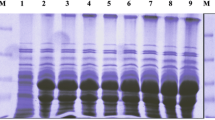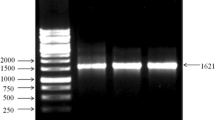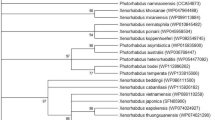Abstract
Photorhabdus temperata and Bacillus thuringiensis are entomopathogenic bacteria exhibiting toxicities against different insect larvae. Vegetative Insecticidal Protein Vip3LB is a Bacillusthuringiensis insecticidal protein secreted during the vegetative growth stage exhibiting lepidopteran specificity. In this study, we focused for the first time on the heterologous expression of vip3LB gene in Photorhabdus temperata strain K122. Firstly, Western blot analyses of whole cultures of recombinant Photorhabdus temperata showed that Vip3LB was produced and appeared lightly proteolysed. Cellular fractionation and proteinase K proteolysis showed that in vitro-cultured recombinant Photorhabdus temperata K122 accumulated Vip3LB in the cell and appeared not to secrete this protein. Oral toxicity of whole cultures of recombinant Photorhabdus temperata K122 strains was assayed on second-instar larvae of Ephestia kuehniella, a laboratory model insect, and the cutworm Spodoptera littoralis, one of the major pests of many important crop plants. Unlike the wild strain K122, which has no effect on the larval growth, the recombinant bacteria expressing vip3LB gene reduced or stopped the larval growth. These results demonstrate that the heterologous expression of Bacillus thuringiensis vegetative insecticidal protein-encoding gene vip3LB in Photorhabdus temperata could be considered as an excellent tool for improving Photorhabdus insecticidal activities.


Similar content being viewed by others
Abbreviations
- B. :
-
Bacillus
- P. :
-
Photorhabdus
- K122:
-
Photorhabdus temperata strain K122
- E. :
-
Ephestia
- S. :
-
Spodoptera
References
James, C. (2003). Global review of commercialized transgenic crops. Current Science, 84, 303–309.
Jouanina, L., Bonade′-Bottinoa, M., Girarda, C., Morrota, G., & Gibanda, M. (1998). Transgenic plants for insect resistance. Plant Science, 131, 1–11.
Jaoua, S., Zouari, N., Tounsi, S., & Ellouz, R. (1996). Study of particular delta-endotoxins produced by three isolated strains of Bacillus thuringiensis. FEMS Microbiology Letters, 145, 349–354.
Schnepf, E., Crickmore, N., Van Rie, J., Lereclus, D., Baum, J., Feitelson, J., et al. (1998). Bacillus thuringiensis and its pesticidal crystal proteins. Microbiology and Molecular Biology Reviews, 62, 775–806.
Bravo, A. (1997). Phylogenetic relationships of Bacillus thuringiensis δ-endotoxin family proteins and their functional domains. Journal of Bacteriology, 179, 2793–2801.
Crickmore, N., Zeigler, D. R., Feitelson, J., Schnepf, E., Van Rie, J., Lereclus, D., et al. (1998). Revision of the nomenclature for the Bacillus thuringiensis pesticidal crystal proteins. Microbiology and Molecular Biology Reviews, 62, 807–813.
de Maagd, R. A., Alejandra, B., & Crickmore, N. (2001). How Bacillus thuringiensis has evolved specific toxins to colonize the insect world. Trends in Genetics, 17, 193–199.
Crickmore, N., Zeigler, D. R., Schnepf, E., Van Rie, J., Lereclus, D., Baum, J., Bravo, A., & Dean, D. H. (2009). Bacillus thuringiensis toxin nomenclature. http://www.lifesci.sussex.ac.uk/Home/Neil_Crickmore/Bt/.
Warren, G. W., Koziel, M. G., Mullins, M. A., Nye, G. J., Carr, B., Desai, N. M., & Kostichka, K. (2000). Genes encoding insecticidal proteins. US Patent 6,066,783.
Warren, G. W. (1997). Vegetative insecticidal proteins: Novel proteins for control of corn pests. In N. B. Carozzi & M. G. Koziel (Eds.), Advances in insect control: The role of transgenic plants (pp. 109–121). London, UK: Taylor and Francis.
Estruch, J. J., Warren, G. W., Mullins, M. A., Nye, G. J., Craig, J. A., & Koziel, M. G. (1996). Vip3A, a novel Bacillus thuringiensis vegetative insecticidal protein with a wide spectrum of activities against lepidopteran insects. Proceedings of the National Academy of Sciences of the United States of America, 93, 5389–5394.
Lee, M. K., Walters, F. S., Hart, H., Palekar, N., & Chen, J. S. (2003). The mode of action of the Bacillus thuringiensis vegetative insecticidal protein Vip3A differs from that of Cry1Ab deltaendotoxin. Applied and Environmental Microbiology, 69, 4648–4657.
Rang, C., Gil, P., Neisner, N., Van Rie, J., & Frutos, R. (2005). Novel Vip3-related protein from Bacillus thuringiensis. Applied and Environmental Microbiology, 71, 6276–6281.
Shen, Z., Warren, G. W., Shotkoski, F., & Kramer, V. (2003). Novel Vip3 proteins and methods of use. International publication number WO/2003/075655.
Bhalla, R., Dalal, M., Panguluri, S. K., Jagadish, B., Mandaokar, A. D., Singh, A. K., et al. (2005). Isolation, characterization and expression of a novel vegetative insecticidal protein gene of Bacillus thuringiensis. FEMS Microbiology Letters, 243, 467–472.
Chen, J.-W., Tang, L., Tang, M., Shi, Y., & Pang, Y. (2002). Cloning and expression product of vip3A gene from Bacillus thuringiensis and analysis of insecticidal activity. China Journal of Biotechnology, 18, 687–692.
Doss, V. A., Kumar, K. A., Jayakumar, R., & Sekar, V. (2002). Cloning and expression of the vegetative insecticidal protein (vip3V) gene of Bacillus thuringiensis in Escherichia coli. Protein Expression and Purification, 26, 82–88.
Yu, C. G., Mullins, M. A., Warren, G. W., Koziel, M. G., & Estruch, J. J. (1997). The Bacillus thuringiensis vegetative insecticidal protein Vip3A lyses midgut epithelium cells of susceptible insects. Applied and Environmental Microbiology, 63, 532–536.
Bauer, L. S. (1995). Resistance: A threat to the insecticidal crystal proteins of Bacillus thuringiensis. The Florida Entomologist, 78, 414–443.
Ferré, J. J., & van Rie, J. (2002). Biochemistry and genetics of insect resistance to Bacillus thuringiensis. Annual Review of Entomology, 47, 501–533.
Gould, F. (1998). Sustainability of transgenic insecticidal cultivars: Integrating pest genetics and ecology. Annual Review of Entomology, 43, 701–726.
Kain, W. C., Zhao, J.-Z., Janmaat, A. F., Myers, J., Shelton, A. M., & Wang, P. (2004). Inheritance of resistance to Bacillus thuringiensis Cry1Ac toxin in a greenhouse-derived strain of cabbage looper (Lepidoptera: Noctuidae). Journal of Economic Entomology, 97, 2073–2078.
Storer, N. P., Peck, S. L., Gould, F., Van Duyn, J. W., & Kennedy, G. G. (2003). Spatial processes in the evolution of resistance in Helicoverpa zea (Lepidoptera: Noctuidae) to Bt transgenic corn and cotton in a mixed agroecosystem: A biology-rich stochastic simulation model. Journal of Economic Entomology, 96, 156–172.
Tabashnik, B. E. (1997). Seeking the root of insect resistance to transgenic plants. Proceedings of the National Academy of Sciences of the United States of America, 94, 3488–3490.
Tabashnik, B. E., Cushing, N. L., Finson, N., & Johnson, M. W. (1990). Field development of resistance to Bacillus thuringiensis in diamondback moth (Lepidoptera: Plutellidae). Journal of Economic Entomology, 83, 1671–1676.
Cohen, E. (1991). Photoprotection of B. t. kurstaki from ultraviolet irradiation. Journal of Invertebrate Pathology, 57, 343–351.
Dunkle, R. L., & Shasha, B. S. (1988). Starch-encapsulated Bacillus thuringiensis: A potential new method for increasing environmental stability of entomopathogens. Environmental Entomology, 17, 120–126.
Zghal, R. Z., Trigui, H., Ali, M. B., & Jaoua, S. (2008). Evidence of the importance of the Met(115) for Bacillus thuringiensis subsp. israelensis Cyt1Aa protein cytolytic activity in Escherichia coli. Molecular Biotechnology, 38, 121–127.
Driss, F., Kallassy-Awad, M., Zouari, N., & Jaoua, S. (2005). Molecular characterization of a novel chitinase from Bacillus thuringiensis subsp. kurstaki. Journal of Applied Microbiology, 99, 945–953.
Ge, A. Z., PWster, R. M., & Dean, D. H. (1990). Hyperexpression of a Bacillus thuringiensis δ-endotoxin-encoding gene in Escherichia coli: Properties of the product. Gene, 93, 49–54.
Odea, K., Oshie, K., Shimizu, M., Nakamura, K., Yamamoto, H., Nakayama, I., et al. (1987). Nucleotide sequence of the insecticidal protein gene of Bacillus thuringiensis strain aizawai IPL7 and its high-level expression in Escherichia coli. Gene, 53, 113–119.
Moar, W. J., Trumble, J., Hice, R., & Backmann, P. (1994). Insecticidal activity of the CryIIA protein from the NRD-12 isolate of Bacillus thuringiensis subsp. kurstaki expressed in Escherichia coli and Bacillus thuringiensis and in a leaf-colonizing strain of Bacillus cereus. Applied and Environmental Microbiology, 60, 896–902.
Falcao Salles, J., DeMedeiros Gitahy, P., Skot, L., & Baldani, J. I. (2000). Use of endophytic diazotrophic bacteria as a vector to express the cry3A gene from Bacillus thuringiensis. Brazilian Journal of Microbiology, 31, 155–161.
Downing, K. J., Graeme, L., & Thomson, J. A. (2000). Biocontrol of the sugarcane Eldanna saccarina by expression of the Bacillus thuringiensis cry1Ac7 and Serratia marcescens chiA genes in sugarcane-associated bacteria. Applied and Environmental Microbiology, 66, 2804–2810.
Marchenko, N. D., Marchenko, G. N., Ganushkina, L. O., & Azizbekyan, R. R. (2000). Cloning and expression of mosquitocidal endotoxin gene cryIVB from Bacillus thuringiensis var israelensis in the obligate methylotroph Methylobacillus Xagellatum. Journal of Industrial Microbiology and Biotechnology, 24, 14–18.
Theoduloz, C., Vega, A., Salazar, M., Gonzalez, E., & Meza-Basso, L. (2003). Expression of a Bacillus thuringiensis delta-endotoxin cry1Ab gene in Bacillus subtilis and Bacillus licheniformis strains that naturally colonize the phylloplane of tomato plants (Lycopersicon esculentum, Mills). Journal of Applied Microbiology, 94, 375–381.
Forst, S., Dowds, B., Boemare, N., & Stackebrandt, E. (1997). Xenorhabdus and Photorhabdus spp.: Bugs that kill bugs. Annual Review of Microbiology, 51, 47–72.
Ffrench-Constant, R., Waterfield, N., Daborn, P., Joyce, S., Bennett, H., Au, C., et al. (2003). Photorhabdus: Towards a functional genomic analysis of a symbiont and pathogen. FEMS Microbiology Reviews, 26, 433–456.
Ffrench-Constant, R. H., Dowling, A., & Waterfield, N. R. (2007). Insecticidal toxins from Photorhabdus bacteria and their potential use in agriculture. Toxicon, 49, 436–451.
Abdelkefi Mesrati, L., Tounsi, S., & Jaoua, S. (2005). Characterization of a novel vip3-type gene from Bacillus thuringiensis and evidence of its presence on a large plasmid. FEMS Microbiology Letters, 244, 353–358.
Abdelkefi Mesrati, L., Tounsi, S., Kamoun, F., & Jaoua, S. (2005). Identification of a promoter for the vegetative insecticidal protein-encoding gene vip3LB from Bacillus thuringiensis. FEMS Microbiology Letters, 247, 101–104.
David, D., Clarke, J., & Dowds, B. C. (1994). The gene coding for polynucleotide phosphorylase in Photorhabdus sp. strain K122 is induced at low temperatures. Journal of Bacteriology, 176, 3775–3784.
Laemmli, U. K. (1970). Cleavage of structural proteins during the assembly of the head of bacteriophage T4. Nature (London), 227, 680–685.
Tounsi, S., Aoun, A. E., Blight, M., Rebaî, A., & Jaoua, S. (2006). Evidence of oral toxicity of Photorhabdus temperata strain K122 against Prays oleae and its improvement by heterologous expression of Bacillus thuringiensis cry1Aa and cry1Ia genes. Journal of Invertebrate Pathology, 91, 131–135.
Poitout, S., & Bues, R. (1970). Elevage de plusieurs espèces de lépidoptères noctuidae sur milieu artificiel riche et sur milieu artificiel simplifié. Annales de Zoologie Ecologie Animale, 2, 79–91.
Acknowledgements
This study was supported by grants from the Ministry of Higher Education, Scientific Research and Technology. We thank the Centre Français pour l’Accueil et les Echanges Internationaux for having provided a fellowship to K.J. for a 2-week-training programme in the Laboratory of E.M.I.P. We thank the Institut de l’olivier de Sfax, Tunisia for providing us with E. kuehniella larvae. We wish to thank Pr. Jamil Jaoua, Head of the English Unit at the Sfax Faculty of Sciences for having proofread this article.
Author information
Authors and Affiliations
Corresponding author
Additional information
Contribution
Kaïs Jamoussi and Sameh Sellami contributed equally to this work and share first authorship.
Rights and permissions
About this article
Cite this article
Jamoussi, K., Sellami, S., Abdelkefi-Mesrati, L. et al. Heterologous Expression of Bacillus thuringiensis Vegetative Insecticidal Protein-Encoding Gene vip3LB in Photorhabdus temperata Strain K122 and Oral Toxicity against the Lepidoptera Ephestia kuehniella and Spodoptera littoralis . Mol Biotechnol 43, 97–103 (2009). https://doi.org/10.1007/s12033-009-9179-3
Received:
Accepted:
Published:
Issue Date:
DOI: https://doi.org/10.1007/s12033-009-9179-3




